Uzbekistan Applied arts

Handicraft developed in Uzbekistan from century to century, leaving unique products of the unknown foremen with rich arts, imaginations and perfection in Uzbek heritage, Due to the changes of social and economic conditions, handicrafts gradually became the second after industrial productions on an extent of 20th century.
Nowadays, in Uzbekistan enormous attention is rendered towards national foremen in the field. The careful attitude towards the traditional cultural values became one of the main ranks of state policy. The revival of handicraft traditions was part of a logical progress, derived from the aspiration to preserve the national culture.
In the last years, the government adopted several laws related to the revival of national handicrafts and traditions. A number of the national artists were elected as the academicians of the Academy of Applied Arts of Uzbekistan. A title «0'zbekiston Respublikasi khalq ustasi" legislatively authorized with Faskhitdin Dadamukhammedov becoming the first handicraft to be called so. At the research and production center "Musavvir" (artist) the association of the national artists "Khunarmand" (skillful craftsman) was formed, the divisions of which operates nationwide. The main aim of these organizations is restoration of forgotten section of art history, assistance to the handicraftsmen in manufacturing and sales of production.
Moreover, the handicraftsmen were assisted by several international funds and organizations, which became possible due to the open state policy.
The organization of various international festivals and fairs became traditional under aegis of the state organizations. These fairs stimulate growth of craft manufacture, promote a rank by experience, and define the market. In 1995, in the first large fair was organized under the supervision of the UN. This initiative was also supported by several other international organizations interested in the development of tourism and economy of the newly independent states. On an extent of a number of years the UN Project "Cultural-educational tourism and handicraft development* and Project «Aid to the handicraftsmen of the Counterpart Consortium, operated in Uzbekistan, which rendered significant support to the national artists.
One of the recent actions by the UN Project as an aid to the handicraftsmen was the sale-exhibition, namely «Craft products of Uzbekistan»
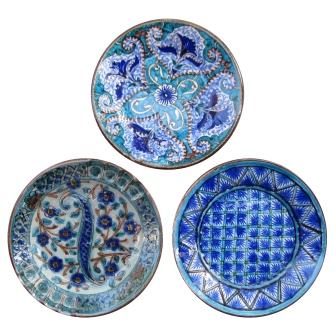 Ceramics - Pottery was one of the most developed manufactures of the Central Asia for several years. Spray and dry ceramics of the leading centers had local peculiarities that have been reflected in the original forms of final products. Number of local pottery centers are preserved to present days, such as Rishton, Ghijduyon, Khiva, Samarkand, Gurumsaray, Shakhrisabz, Urgut, Khorezm and Tashkent.
Ceramics - Pottery was one of the most developed manufactures of the Central Asia for several years. Spray and dry ceramics of the leading centers had local peculiarities that have been reflected in the original forms of final products. Number of local pottery centers are preserved to present days, such as Rishton, Ghijduyon, Khiva, Samarkand, Gurumsaray, Shakhrisabz, Urgut, Khorezm and Tashkent.
In the last years, historic centers of manufacture are revived, assortment of products extended with their quality improving significantly. Feeling support on the part of the state, now foremen are increasing production to extend competitiveness of their products. They strive to preserve local features of production, and are restoring the forgotten forms and drawings. At the same time, new forms of handicraft motives are emerging.
The artists of the Samarkand school revive traditions of an ornament of vessels by elements of animals and birds.
In Rishton elder artists and representatives of young generation are masters of both - technical and handicraft motives (kuzagar and nakkosh). Distinctive, feature of Rishton ceramics is a dichromatic Color, and syrup paint, which is usually taken from the ashes of plants. At the moment, die artists work with ready alkaline products. Foremen in the area mainly produce ceramics with paintings of various flora, as well as knife, birds, fishes, and architectural motives. Tradition of manufacturing the duck-style vessel for mussallas (local wine) is revived.
Toys made of earthen - the main attribute of the ancient religious rituals - are also revived. However, this kind of handicraft, which was inherent to Bukhara school of ceramics, has practically ceased to exist.
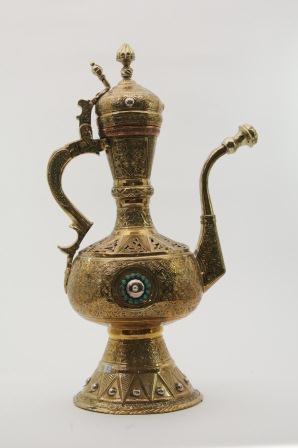 Engraving (toreutics) - Modern foremen, who work with a brass and copper, manufacture high quality products of engraving. A subtlety and wealth of patterns are inherent in the ware by the Bukhara foremen. Most of the Bukhara craftsmen were students of the famous national engraver S. Khamidov, who used to revive the art of metal engraving in Bukhara in the early 60s. Today they work in the workshop «Kandakor» name after Usto Khamidov. Alongside the use of traditional forms of products, now foremen search for new forms and styles in the field. Thus, they make trays and dishes, frequently depicting images of famous.monuments of the Bukhara architecture. Some forms of household ware are already out of use, for example, traditional hand-washers used in the Orient, namely "dast shu", but craftsmen are still producing them. Due to their wonderful design, these products became a wonderful souvenier. Jugs by the Bukhara artist, Sh. Ibodov, made by way of forging and engraving went on display in exhibitions in Khiva, Almaty and Bishkek.
Engraving (toreutics) - Modern foremen, who work with a brass and copper, manufacture high quality products of engraving. A subtlety and wealth of patterns are inherent in the ware by the Bukhara foremen. Most of the Bukhara craftsmen were students of the famous national engraver S. Khamidov, who used to revive the art of metal engraving in Bukhara in the early 60s. Today they work in the workshop «Kandakor» name after Usto Khamidov. Alongside the use of traditional forms of products, now foremen search for new forms and styles in the field. Thus, they make trays and dishes, frequently depicting images of famous.monuments of the Bukhara architecture. Some forms of household ware are already out of use, for example, traditional hand-washers used in the Orient, namely "dast shu", but craftsmen are still producing them. Due to their wonderful design, these products became a wonderful souvenier. Jugs by the Bukhara artist, Sh. Ibodov, made by way of forging and engraving went on display in exhibitions in Khiva, Almaty and Bishkek.
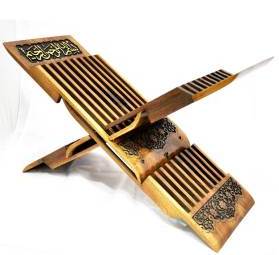 Wood carving - Masters of wood carving in Kokand National Heritage Centen of «Oltin meras» Fund use oak and nut trees. Creating traditional products common in the East (caskets, bookshelves and carved tables), they generously transfer rich traditions of geometrical ornaments.
Wood carving - Masters of wood carving in Kokand National Heritage Centen of «Oltin meras» Fund use oak and nut trees. Creating traditional products common in the East (caskets, bookshelves and carved tables), they generously transfer rich traditions of geometrical ornaments.
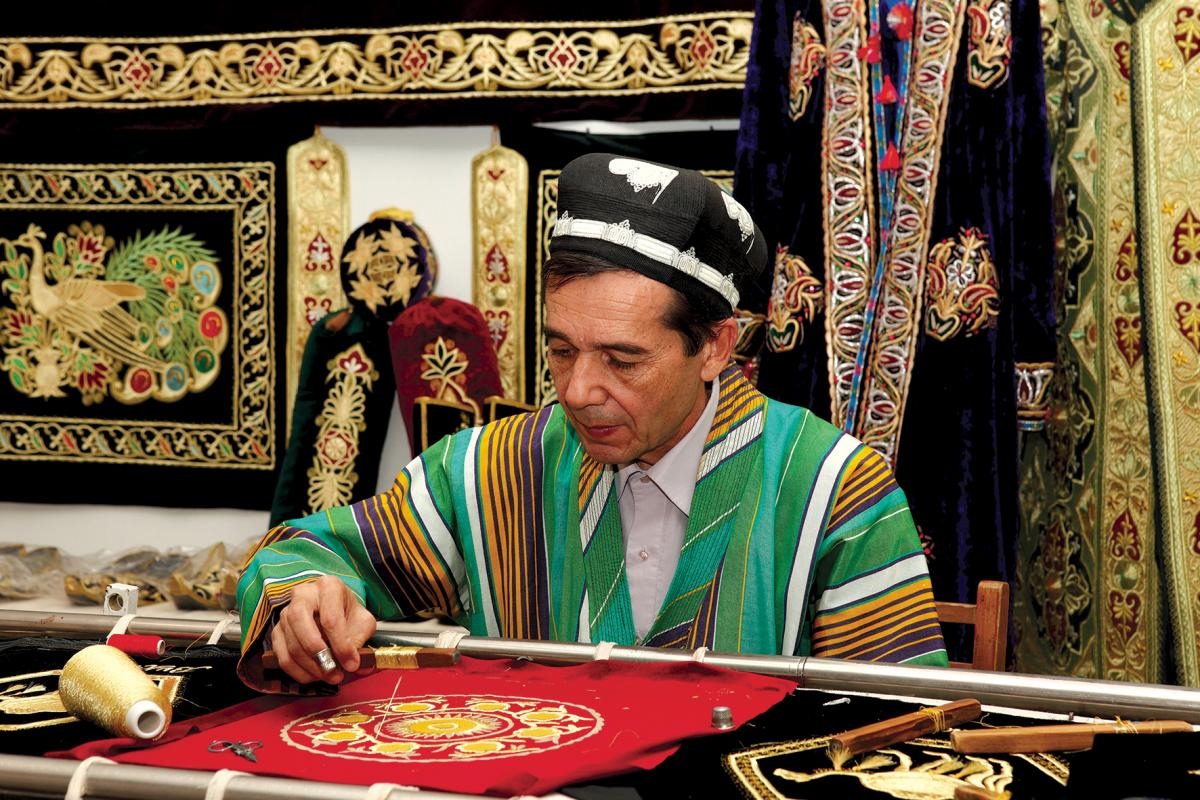 Golden embroidery - Traditional center of this kind of craft is Bukhara. Today embroidery art is popular among the younger generation, as well, The foremen produce goods in the best traditions of the Bukhara gold embroidery.
Golden embroidery - Traditional center of this kind of craft is Bukhara. Today embroidery art is popular among the younger generation, as well, The foremen produce goods in the best traditions of the Bukhara gold embroidery.
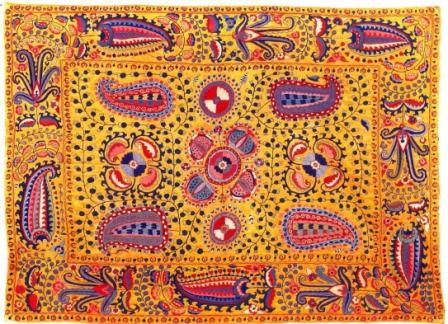 Embroidery - Traditional centers of manufacturing of suzana are: Nurata, Bukhara, Samarkand, Shakhrisabz, Tashkent and Ferghana. Many young artists have become interested in these kinds of art. This is, not casual - as if creative energy in the people has woken up, by feeling an opportunity of practical realization and material effect, which in its turn led to the flourishing of many kinds of traditional arts.
Embroidery - Traditional centers of manufacturing of suzana are: Nurata, Bukhara, Samarkand, Shakhrisabz, Tashkent and Ferghana. Many young artists have become interested in these kinds of art. This is, not casual - as if creative energy in the people has woken up, by feeling an opportunity of practical realization and material effect, which in its turn led to the flourishing of many kinds of traditional arts.
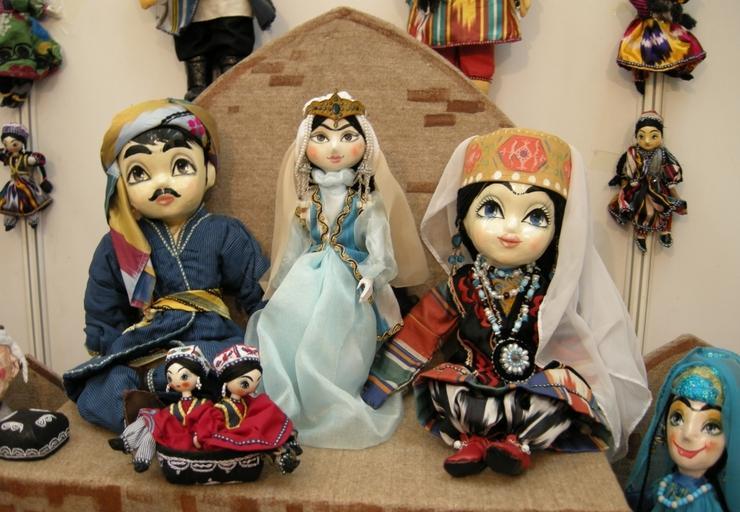 Dolls - Manufacturing of dolls is one of the practically lost and revived arts. In recent.history, theatrical presentations of.dolls were the favorite entertainment-of both village and town dwellers. Dolls in national.costumes are not just Uzbek national toys, but valuable Uzbek souvenirs as well. They represent various national types of heroes or literary products. The doll masters of Bukhara study a history of a Bukhara costume, use traditional technology of tailoring, embroidery, and the Bukhara karakul fur.
Dolls - Manufacturing of dolls is one of the practically lost and revived arts. In recent.history, theatrical presentations of.dolls were the favorite entertainment-of both village and town dwellers. Dolls in national.costumes are not just Uzbek national toys, but valuable Uzbek souvenirs as well. They represent various national types of heroes or literary products. The doll masters of Bukhara study a history of a Bukhara costume, use traditional technology of tailoring, embroidery, and the Bukhara karakul fur.
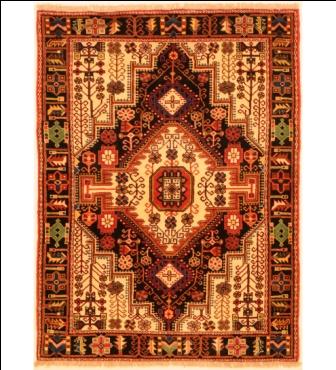 Carpet weaving - Now manufacturing of carpets in Uzbekistan develops in three directions: homemade, state and private companies. Homemade carpets are produced in the Ferghana and Nurata valleys, Kashkadarya, Surkhandarya, Syrdarya provinces, and Karakalpakstan. Centers on manufacture and sales of carpets are also developed in Samarkand, Urgut, Kokand, and Khorezm. Carpet masters produce all kinds of carpets in these provinces. The State association "Usto" and the republican industrial center of ancient and applied art, "Musavvir", carry out large scientific and practical works on restoration of ancient drawings and technologies.
Carpet weaving - Now manufacturing of carpets in Uzbekistan develops in three directions: homemade, state and private companies. Homemade carpets are produced in the Ferghana and Nurata valleys, Kashkadarya, Surkhandarya, Syrdarya provinces, and Karakalpakstan. Centers on manufacture and sales of carpets are also developed in Samarkand, Urgut, Kokand, and Khorezm. Carpet masters produce all kinds of carpets in these provinces. The State association "Usto" and the republican industrial center of ancient and applied art, "Musavvir", carry out large scientific and practical works on restoration of ancient drawings and technologies.








 +99890 979 38 98
+99890 979 38 98 +99871 252 52 32
+99871 252 52 32 +99871 252 61 84
+99871 252 61 84



























